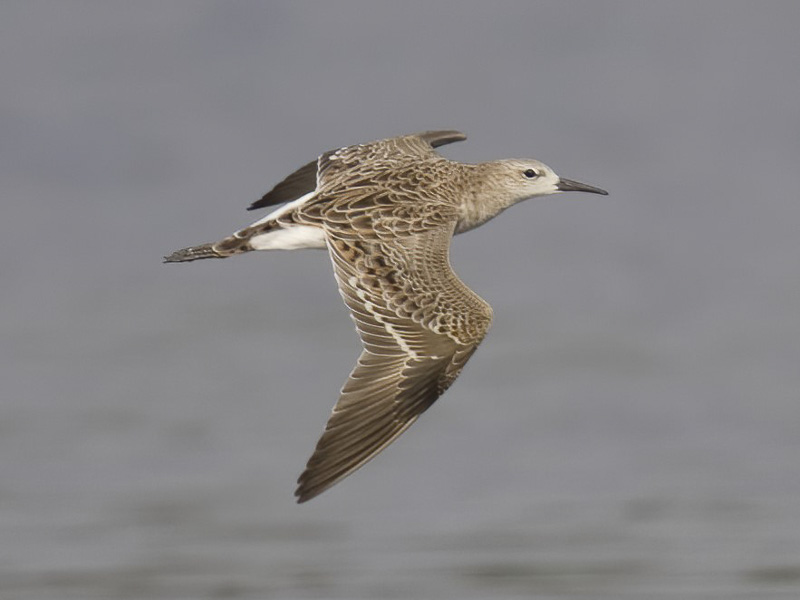Ruff Calidris pugnax 流蘇鷸
Category I. Scarce passage migrant, rare in winter, mainly in intertidal areas of Deep Bay and adjacent roost sites.
IDENTIFICATION

Apr 2004, John and Jemi Holmes. Male.
Male 26-32 cm, female 20-25 cm. Ruffs (males) approach the size of Common Redshank, while Reeves (females) are close to Marsh Sandpiper in body length, if not bulk. Males such as this that have begun moult into breeding plumage show a combination of plain or barred feathers that can be black through rufous to white. Females in breeding plumage are mottled or spotted on the underparts.

Nov. 2022, Sarawak, Malaysia. Dave Bakewell. Adult, non-breeding plumage.
Ruff is structurally distinct in having a large body but a small head and fairly long neck; the bill is moderate in length, fairly deep-based and slightly decurved. Leg colour is variable ranging from yellowish to a quite bright orange that is similar to Common Redshank.
In non-breeding plumage rather greyish in tone with pale diffuse grey-brown fringes to upperpart feathers; males usually have pale around bill base. Juveniles have dark feather centres (some birds have buff internal markings) with clear cut pale buff fringes on upperparts and buff chest and belly.

Sep. 2023, Michelle and Peter Wong. Male.
This male in autumn shows remnants of breeding plumage.

Dec. 2012, Martin Hale. Male.
In flight obvious pale sides to the rump, a narrow white inner wing bar and diffuse pale area at base of inner primaries.
VOCALISATIONS
There are no reports of vocalisations in HK, and this species is only known to utter simple sounds.
DISTRIBUTION & HABITAT PREFERENCE
Most records occur in the Deep Bay area, usually on the intertidal mudflats or at roost on the adjacent ponds of Mai Po NR; there are a small number of records of singles on commercial fish ponds, at HK Wetland Park, Lok Ma Chau MTRC Ecological Enhancement Area and San Tin East Main Drainage Channel.
Away from the Deep Bay area there are records in grassy or freshwater marsh areas at Kai Tak airport during 20-21 March 1979, Tai Po on 4 October 1981, Kam Tin on 22 October 1995, Chek Lap Kok airport on 7 September 2001 and Tung Chung on 25 August 2013 (all single birds), while there were two at Pui O on 10 May 2019.
OCCURRENCE
Ruff is a scarce passage migrant and rare winter visitor. Figure 1 illustrates occurrence as recorded by systematic shorebird counts at Mai Po and indicates numbers recorded are generally low, usually only one bird, and passage is slightly stronger in autumn than spring.
In autumn the earliest record is on 12 August 2003, while main autumn passage occurs from the second week of September to the end of October, with a peak during October.
It appears that Ruff has become scarcer in the winter as, despite increased observer activity, the number of birds recorded from the first week of November to the first week of March is lower than it was in the 1980s and 1990s.
Ruff is an early migrant in spring, with passage probably beginning as early as early March. Main passage occurs from the last week of March to the third week of April, with numbers slightly higher in the first half of that period; the highest count in spring is five. The latest spring record is of one from 21 May to 4 June 1988. There is only one summer record: one on 1 July 1989.
Approximately 86% of records have involved one or two birds, and the highest count on record is ten on 25 October 1999.
Dove and Goodhart (1955) recorded up to two birds from 17 April to 3 May and on 21 September, noting that these were the first records for HK. Macfarlane and Macdonald (1966) reported eight records from 17 April to 3 May and 21 September to 4 October.
BEHAVIOUR, FORAGING & DIET
Although generally recorded in intertidal areas, it has been seen foraging in grassy areas such as those at airports, freshwater marshes and even the edge of urban areas.
RANGE & SYSTEMATICS
Monotypic. Breeds in taiga zone of northern Palearctic from Sweden east to northeast Asia, with other breeding areas at higher altitude further south, including Transbaikalia and northern Kamchatka; winters largely in sub-Saharan Africa, but also along coasts from the Middle East through south Asia to Indochina, Indonesia and the Philippines (Van Gils et al. 2020). In China it is a migrant through much of the country and winters along the south coast, including Taiwan and Hainan (Liu and Chen 2021).
CONSERVATION STATUS
IUCN: Least Concern. Population trend decreasing.
Figure 1.

Dove, R. S. and H. J. Goodhart (1955). Field notes on local bird records. Memoirs of the Hong Kong Biological Circle 1: 1-4.
Liu, Y. and S. H. Chen (eds) (2021). The CNG Field Guide to the Birds of China (in Chinese). Hunan Science and Technology Publication House, Changsha.
Macfarlane, A. M. and Macdonald, A. D., revised by Caunter, J. R. L. and Macfarlane, A. M. 1966. An Annotated Check-list of the Birds of Hong Kong. Hong Kong Bird Watching Society, Hong Kong.
Van Gils, J., P. Wiersma, and G. M. Kirwan (2020). Ruff (Calidris pugnax), version 1.0. In Birds of the World (J. del Hoyo, A. Elliott, J. Sargatal, D. A. Christie, and E. de Juana, Editors). Cornell Lab of Ornithology, Ithaca, NY, USA. https://doi.org/10.2173/bow.ruff.01

